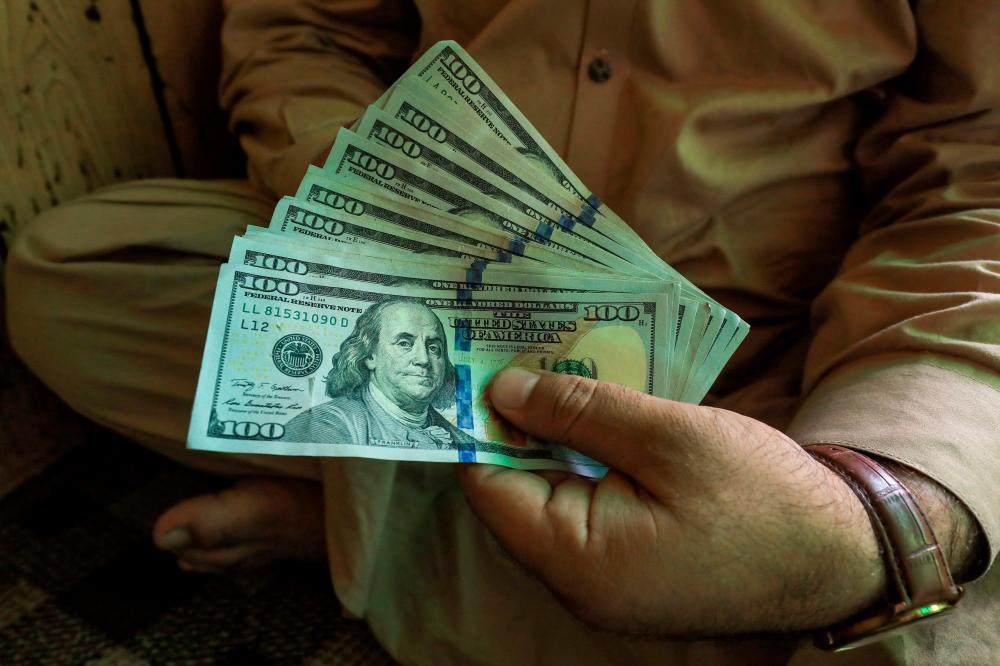NEW YORK: The US dollar surged this year to its highest in two decades and there are still plenty of bulls betting the greenback has legs to keep climbing thanks to a hawkish Federal Reserve (Fed) and economic news that should keep America ahead of other major economies.
The dollar is up about 13.5% this year against a basket of peers, on pace for its strongest year in nearly 40 years, while the euro has been crushed about 12% to below parity, a level untouched in two decades.
Lifted by the Fed aggressively increasing rates and buyers seeking a safe-haven asset from the Russia-Ukraine war and other areas of global uncertainty, the dollar has been a surefire bet for investors.
The greenback has risen against every G10 currency, up 19% against the Japanese yen and 15% versus the British pound.
“We have been structurally dollar bullish for something like the last 15 months ... it feels a bit long in the tooth but we are never finding reasons to change,” said Credit Suisse Group AG’s global head of forex strategy Shahab Jalinoos.
JPMorgan analysts pointed to “encouraging” recent US economic data on inflation and payrolls, compared with “vulnerability” growing in Europe and China, as a key reason for the dollar’s continued rise.
The US consumer price index rose at an annual rate of 8.5% in July, a decline from the 9.1% reported for June, while an unexpected acceleration in job growth in July diminished fears the economy was in recession.
The same cannot be said about other major economies.
The Bank of England forecasts that Britain will enter recession later this year as surging energy bills help drive inflation higher into double digits.
Europe is also now approaching double-digit inflation, driven in large part by the continuing Russia-Ukraine conflict and resulting energy crisis. Economists see risks that the continent could get embedded in a hard-to-break wage-price spiral, making investors reluctant to buy the euro even after its steep decline.
“The biggest concern in Europe is energy ... that is keeping the dollar up and the European currencies under pressure,” said Ugo Lancioni, head of currency management at Neuberger Berman.
Meanwhile, China’s central bank this month cut key lending rates in a surprise move to revive demand as the economy unexpectedly slowed in July, with factory and retail activity squeezed by Beijing’s zero-Covid policy and a property crisis.
In the rest of the world, a strong dollar can help some other countries with exports and their balance of trade, but it exacerbates other problems: Oil and other dollar-denominated commodities cost more for buyers using other currencies and it becomes harder for companies and governments to service dollar debt.
“Much of the dollar’s dominance is due to simply seeing how the US is able to cushion itself from all the negativity that has developed,” said Juan Perez, director of trading at Monex USA in Washington.
Aggressive Fed rate increases aimed at stamping out inflation have made the dollar more attractive, pushing yields on US debt higher than those in many developed countries – a trend that is likely to continue, said Rob Haworth, senior investment strategy director at US Bank Wealth Management.
“We just don’t see a change in this fundamental paradigm which is that the Federal Reserve is probably still the most aggressive of the major central banks,” he added.
Fed officials at the central bank’s annual meeting in Jackson Hole, Wyoming, on Thursday reiterated that they will drive rates up and keep them there until inflation has been squeezed from the economy.
Investors remain bullish on the dollar even at its elevated levels.
Speculators’ net long positioning on the currency rose in the latest week to US$13.37 billion, broadly in line with how large that position has been since July 2021, according to calculations by Reuters based on US Commodity Futures Trading Commission data.
While Lancioni believes the dollar is overvalued in the long run, he is hesitant to bet against it. “It’s is very difficult to go against the dollar right now,” he said.
Investors will listen carefully to Fed chair Jerome Powell at the Jackson Hole conference today for a clearer picture of his thinking on the economic outlook.
“If Powell even hints inflation is easing and supply chain challenges are easing ... any words like that, combined with stronger rhetoric from the ECB, could weigh on the dollar,” said Quincy Krosby, chief global strategist for LPL Financial. – Reuters














